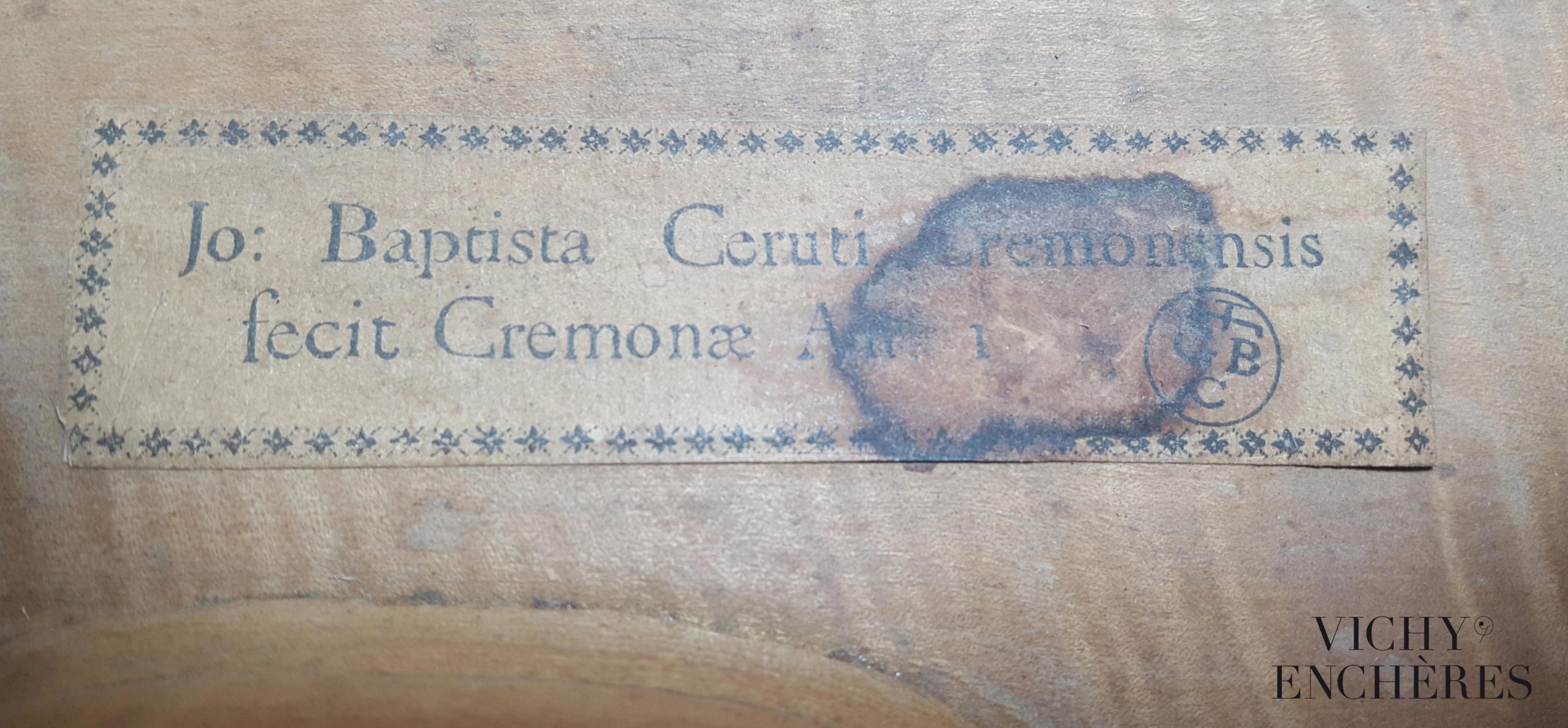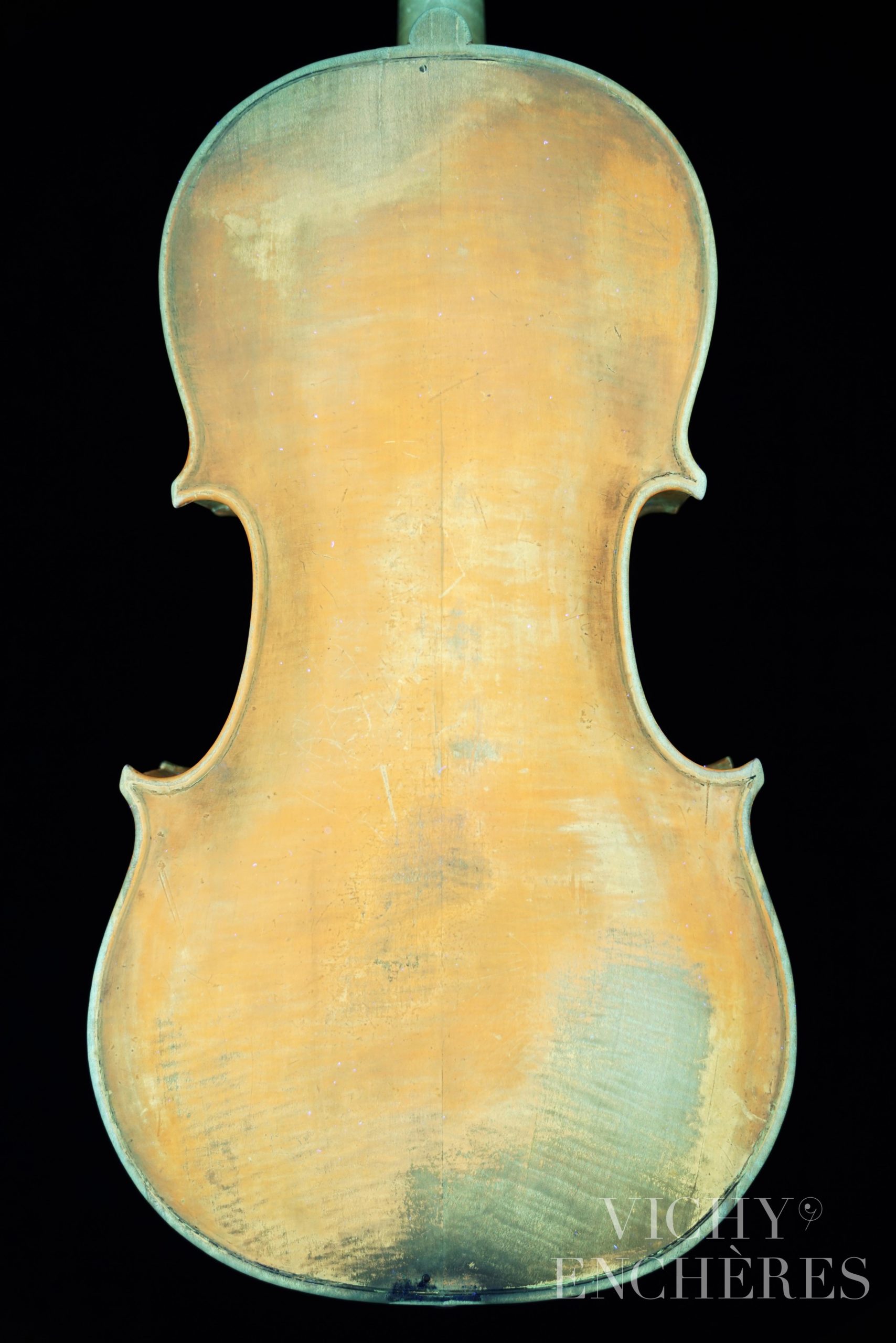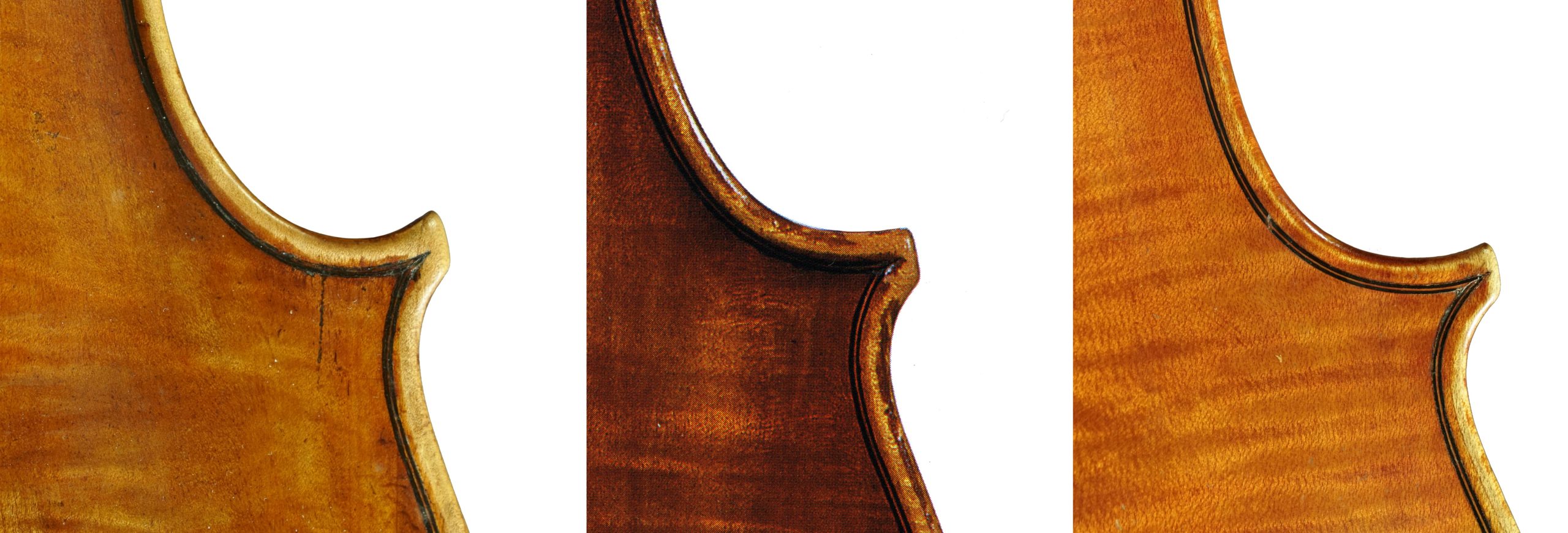Le jeudi 6 décembre 2018, un violon de Giovanni Battista CERUTI fait vers 1810 était mis en vente à Vichy. L’occasion pour nous de revenir sur son auteur dont la reconversion tardive ne sera en rien un frein à un travail particulièrement intense et prolifique…
Un article de Jean-Jacques RAMPAL et Jonathan MAROLLE • MaisonVATELOT RAMPAL
La dynastie des Ceruti est probablement la moins connue de toutes les dynasties de luthiers crémonais. Elle n’en demeure pas moins l’une des plus importantes dans une certaine mesure. En effet, ses membres sont les derniers représentants de la légendaire « École crémonaise ». Ce qui avait commencé presque trois siècles plus tôt avec les Amatis se termine à la fin du 19ème siècle avec les Ceruti…
Giovanni Battista Ceruti, né en 1756 dans une petite ville au nord de Crémone nommée Sesto est tisseur de métier. Son installation à Crémone date de 1786, il a alors 30 ans. Comment vient-il à la lutherie ? Aujourd’hui encore, plusieurs hypothèses subsistent. Longtemps considéré comme un élève de Lorenzo Storioni, il est plus vraisemblable qu’il ait apprit les rudiments du métier vers le milieu des années 1790 avec un certain Comte Luigi Maggi, crémonais lui-même, amateur passionné de lutherie.
Il est également probable que Ceruti ait pu avoir des contacts avec les frères Bergonzi (encore actifs à cette époque) et Giovanni Rota, lui, élève de Lorenzo Storioni.
Toujours est-il qu’en 1802, Ceruti reprend l’atelier de Storioni lorsque ce dernier quitte Crémone. On imagine le chemin parcouru par ce tisserand de formation venu sur le tard à la lutherie et qui succède au luthier le plus connu de Crémone en ce début de 19ème siècle. Il reste à Ceruti 15 années à vivre. Elles seront très prolifiques.
Le violon de Giovanni Battista Ceruti vendu à Vichy en décembre 2018, fait à Crémone vers 1812 (l’étiquette est originale mais malheureusement la date est illisible) est un formidable témoignage du travail du maitre en ce début de 19ème siècle. Conçu sur un modèle « Amati » (il s’agit ici de l’interprétation très personnelle de Ceruti), le coffre de l’instrument est paradoxalement un peu long (360mm). Cette impression de « grandeur » est accentuée par l’étroitesse du modèle, caractéristique propre à Ceruti et par la taille réduite des ouïes (moins de 70mm).


L’érable utilisé pour le fond, les éclisses et la tête est en « opio » (érable de pays) tout à fait caractéristique du bois employé par les luthiers crémonais à partir de la 2ème parie du 18ème siècle. C’est un bois à petites ondes irrégulières, de couleur légèrement grise. Le bois de la tête est sans ondes, vieille tradition italienne.
Le vernis est d’un beau brun aux reflets dorés. Sa texture est légèrement sèche et son épaisseur est plutôt fine. A la lumière U.V, le vernis apparait de couleur orange de façon uniforme. Tous ces éléments nous permettent de penser que la composition du vernis est un mélange de résines diluées dans l’alcool.
Un détail stylistique très intéressant chez Giovanni Battista Ceruti que l’on retrouve chez son fils Giuseppe et son petit-fils Enrico est la manière dont il façonne les coins. Avec une orientation très verticale, cela donne une impression d’un coin très profilé, presque un peu « agressif ».

Le montage intérieur est réalisé sans soin particulier. Les contre-éclisses en saule sont enclavées dans les « cc » à la manière « allemande » et ajustée avec beaucoup d’irrégularités. Les coins et tasseaux sont en sapin, mieux finis.
Giovanni Battista ne fût certainement pas le plus talentueux des luthiers de Crémone, mais par sa détermination, les nécessités de la vie probablement et surtout son talent, il est parvenu à faire perdurer une tradition qui semblait devoir disparaitre avec Lorenzo Storioni. Mieux encore, il sût transmettre un savoir acquis tardivement, à son fils et petit-fils et créer un véritable courant d’inspiration pour de nombreux luthiers italiens venus à sa suite. Ne fait pas école qui veut.
Oui, Giovanni Battista Ceruti a bien mérité sa place -si particulière qu’elle soit de par son parcours atypique- parmi ses illustres prédécesseurs crémonais.
On Thursday December 6th, 2018, a violin by Giovanni Battista CERUTI made around 1810 was presented in Vichy. Let’s descovered this author whose had an intense and prolific work despite his late reconversion…
An article by Jean-Jacques RAMPAL & Jonathan MAROLLE • MaisonVATELOT RAMPAL
The Ceruti dynasty is probably the least known of all the Cremonese violin-making dynasties. It is, however, amongst the most important ones in one particular respect: its members were the last standing representatives of the legendary Cremonese school. What started almost three centuries before with the Amatis, finished at the end of the 19th century with the Ceruti.
Giovanni Battista Ceruti was born in 1756 in Sesto, a small town north of Cremona, and was a weaver by profession. He settled in Cremona in 1786, aged 30. How did he end up a violin-maker? A number of theories about this exist to this day. Despite having long been thought to be a pupil of Lorenzo Storioni, it is more likely he learned the basics of the trade towards the middle of the 1790s with a certain Count Luigi Maggi, a passionate amateur violin-maker from Cremona.
It is also likely that Ceruti could have been in contact with the Bergonzi brothers (who were still active at the time) as well as Giovanni Rota, who was a pupil of Lorenzo Storioni.
In any case, in 1802 Ceruti took over the workshop of Storioni after he left Cremona. We can only speculate about the path that led this weaver by profession, who later converted to violin-making, to succeed the most famous violin-maker in Cremona at that time, in the early 19th century. Ceruti only had 15 years left to live; they would turn out to be very productive.
The violin by Giovanni Battista Ceruti for sale in Vichy in December 2018, made in Cremona around 1822 (whose label is original but on which the date is illegible) is a wonderful testimony to the work of this master at the beginning of the 19th century. Despite being based on an ‘Amati’ pattern (albeit a very personal interpretation by Ceruti of this pattern), the body of the instrument is rather long (360mm). This impression of the instrument’s length is exacerbated by its narrow width, a characteristic of Ceruti’s instruments, and the diminutive size of the f-holes (less than 70mm).


The maple used for the back, the ribs and the head is ‘opio’ (a local variety), very typical of the wood used by Cremonese violin-makers from the second half of the 18th century onwards. It’s a wood with small irregular figure, slightly grey in colour. The wood for the head is plain, a common feature in Italian lutherie.
The varnish is of a handsome brown with golden reflections. Its texture is slightly dry, and rather thin. Under U.V. light, the varnish appears orange throughout. All these observations lead us to believe that it is composed of a mix of resins diluted in alcohol.
A very interesting stylistic aspect of Giovanni Battista Ceruti’s instruments, which can also be found in his son Giuseppe’s and his grandson Enrico’s instruments, is the way in which the corners have been shaped. With their orientation pointing markedly outwards, they give the impression of being very fluted, appearing rather bold.

The internal construction was carried out without excessive care. The willow linings were inserted in the CCs in the ‘German’ style, and roughly adjusted, with many irregularities left unfinished. The top, bottom and corner blocks are of pine, and better finished.
Giovanni Battista was certainly not the most talented Cremonese violin-maker, but thanks to his determination, the demands of life, and most of all his talent, he was able to continue a tradition that was set to end with Lorenzo Storioni. Better still, he saw the need to pass on the knowledge he acquired late in life to his son and grandson, thus setting the ground for future generations of violin-makers whom he inspired. Not everyone is capable of starting a school of making.
Indeed, Giovanni Battista Ceruti deserves his place – peculiar as it is, due his unorthodox path – amongst his illustrious Cremonese predecessors.